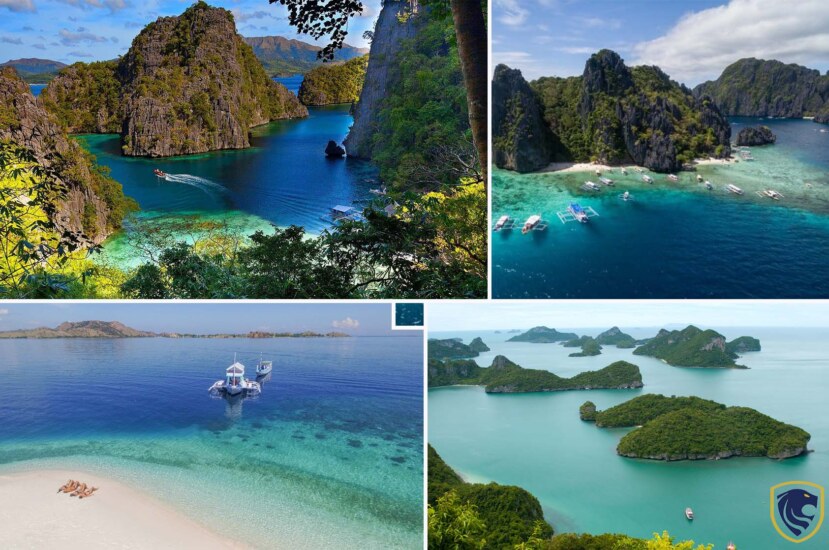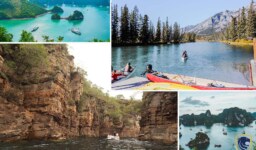Welcome to the enchanted realm of paradise island hopping! Archipelagos, with their captivating clusters of islands, provides a one-of-a-kind and picturesque tourist experience. Consider traveling to isolated and exotic locations, where each island has its special charm and fascination. These archipelagos highlight the range of nature’s splendor, from white sandy beaches and turquoise oceans to lush woods and volcanic scenery. Moreover, this island allows you to discover hidden jewels and immerse yourself in local cultures, whether you want leisure on quiet coastlines or adventurous experiences. So, in this post, we will take you on a tour of some of the world’s most beautiful archipelagos, each of which promises amazing memories and exceptional adventures. So pack your luggage, put on your sun hat, and prepare to embark on an adventure.
How Do Archipelagos Islands Form?
Archipelagos means a group of islands, that have been created over millions of years as a result of numerous geological processes. Volcanic activity is one typical cause, in which undersea volcanoes erupt and build up layers of lava and ash. Eventually, they rise above the ocean surface as islands. The Hawaiian Islands are an excellent illustration of this type of volcanic development. Archipelagos have also been created as a result of tectonic plate movements. When two plates meet, one may be driven beneath the other, resulting in the formation of a subduction zone. Volcanic arcs form as the subducted plate melts and rises, resulting in the formation of island chains. The Japanese Archipelago is a prime example of this phenomenon.

How Do Archipelagos Islands Form?
Some archipelagos have also been shaped by glacial action. Large ice sheets blanketed regions of the Earth during the previous ice age. As these ice sheets melted, valleys and basins formed, resulting in a network of linked islands similar to the Scandinavian Archipelago. Archipelago creation has also been aided by erosion. Continuous wave action and weathering have eroded softer rock, leaving behind tougher elements that will ultimately form islands. The British Isles are a prime example of this sort of archipelago creation. Rising sea levels can also cause archipelagos. During glaciation, water is trapped under ice sheets, causing sea levels to fall. When the ice melts, sea levels rise, submerging low-lying regions and generating island clusters. An archipelago established as a result of this process is the Florida Keys.
Archipelagos and tourism
Archipelagos are known for their breathtaking splendor, making them popular tourist destinations. Tourists flock to these island groups for a variety of reasons, including their gorgeous beaches, diverse marine life, and distinct civilizations. Island hopping is a common pastime in archipelagos, allowing visitors to see many islands in a single trip. From hidden coves to lively fishing communities, each island has its distinct charm and intrigue. Water-based activities abound in the archipelagos, with snorkeling, scuba diving, and boat cruises among the most popular. Moreover, visitors may immerse themselves in the beautiful underwater worlds of coral reefs and marine life through these activities.
Many archipelagos are rich in history and culture. Tourists may learn about the island’s past and present by visiting historic ruins, traditional villages, and museums. Fresh fish and local delicacies are hallmarks of the gastronomic scene in archipelagos. So, tourists may sample a variety of flavors while taking in the gorgeous scenery. The preservation of archipelago ecosystems is critical for long-term tourism.

Archipelagos and tourism
Responsible practices, such as trash management and endangered species preservation, are critical to preserving these pristine landscapes for future generations. Archipelago tourism may give significant economic advantages to local communities. Residents’ livelihoods are supported by jobs in hospitality, tour operations, and crafts.
The rush of tourists, though, can put a strain on resources and infrastructure. Sustainable tourism practices are critical for striking a balance between protecting archipelagos’ natural beauty and addressing visitor needs. Archipelagos must also invest in transportation and lodging to improve the visitor experience. Tourists may easily visit and enjoy the numerous islands thanks to the well-developed infrastructure.
Most Beautiful Archipelagos

Maldives
Maldives
The Maldives is a lovely archipelago in the Indian Ocean noted for its postcard-perfect beauty. It provides the perfect tropical retreat, with pure white sandy beaches, crystal-clear turquoise seas, and elegant overwater bungalows. Visitors may enjoy world-class snorkeling and diving to explore the vivid coral reefs and interact with a variety of aquatic life, including manta rays and whale sharks. The Maldives’ remote resorts and tranquil ambiance make it a perfect romantic getaway for honeymooners and couples.
Galapagos Islands

Galapagos Islands
The Galapagos Islands, located in the Pacific Ocean, are a UNESCO World Heritage site and a biodiversity hotspot. These volcanic islands, known for their unusual and courageous fauna, including giant tortoises, marine iguanas, and blue-footed beaches, provide a once-in-a-lifetime wildlife encounter. Also, the pristine environments have been conserved thanks to conservation initiatives, giving the Galapagos a natural laboratory for scientific inquiry. Tourists may see the interesting and diverse flora and wildlife that inspired Charles Darwin’s theory of evolution on guided excursions and cruises.
Seychelles
The Seychelles archipelago, located off Africa’s eastern coast, is a beautiful tropical paradise with quiet beaches. Its granite and coral islands have amazing rock structures and marine life. On Praslin Island, the Vallée de Mai is a UNESCO World Heritage site and home to the rare coco de mer palm. Furthermore, the luxurious resorts, rich Creole culture, and ocean sports like sailing and fishing make the Seychelle a popular vacation for visitors seeking tranquility and natural beauty.

Seychelles
Greek Islands
The Greek Islands are famous for their rich history, beautiful architecture, and enthralling scenery. Each island provides a distinct combination of history and culture, from the white-washed structures of Santorini perched on volcanic cliffs to the ancient ruins of Delos and Rhodes. The Aegean Sea’s blue waters are ideal for swimming, sailing, and discovering secret coves. The Greek Islands offer travelers an amazing and culturally enlightening experience with their sun-soaked beaches, picturesque towns, and wonderful cuisine.

Greek Islands
Hawaiian Islands
The Hawaiian Islands are a diversified archipelago in the Pacific Ocean that is home to several natural beauties. Each island has a distinct topography, from the volcanic volcanoes of Hawaii (the Big Island) to the lush rainforests of Kauai and the gorgeous beaches of Maui. Moreover, the traditional Hawaiian culture may be experienced through hula performances, luaus, and lei-making courses. The Hawaiian Islands are a popular destination for travelers seeking adventure, leisure, and a taste of Polynesian culture because of its Aloha attitude, friendly hospitality, and breathtaking beauty.

Hawaiian Islands




